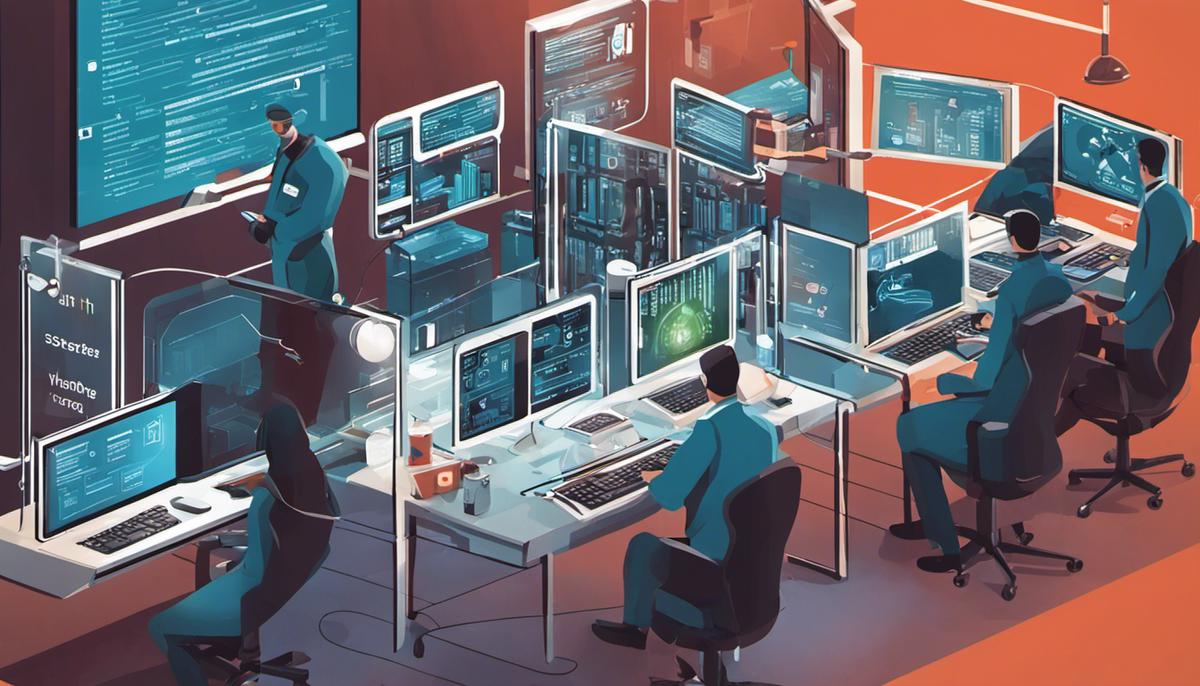There is an urgent need for stringent healthcare cybersecurity, not just to protect sensitive patient data but also to ensure the seamless operation of healthcare ecosystems and safeguard the integrity of innovative medical research. This discussion embarks on a comprehensive journey through the role cybersecurity plays in healthcare, discerning the nature and impact of various cyber threats, exploring the present cybersecurity measures and policies, and looking ahead at the advancements and forthcoming challenges in the domain of healthcare cybersecurity.
The Importance of Cybersecurity in Healthcare
The Imperative of Cybersecurity within the Healthcare Sector
The significance of cybersecurity is broad and inescapable in the interconnected and technologically driven world of the 21st Century. Yet, there is a notable sector where the stakes of this burgeoning discipline are particularly high – the healthcare sector. Here, cybersecurity is not merely a question of data integrity or financial losses, as important as these aspects are. Quite literally, lives hang in the balance.
In the expanse of the healthcare system, the cyber domain stands as a critical platform, including patient records, medical technologies, and communication networks, amassing a diverse spectrum of vulnerabilities susceptible to cyber threats. Threat actors exploit these vulnerabilities with malicious intent, targeting not only a rich deposit of sensitive data but also the timely and efficient functioning of healthcare services.
Healthcare data, due to its personal and sensitive nature, presents unique opportunities for cybercriminals. These data can be repurposed for nefarious activities such as identity theft, fraud, and even blackmail. Moreover, when healthcare systems succumb to cybersecurity breaches, access to crucial medical records can be disrupted, causing distressing delays in patient care and diagnosis.
Advanced medical technologies like Internet of Medical Things (IoMT) devices, now common features in managing health services, have multiplied the potential vulnerabilities inherent in healthcare cyber ecosystems. While these technologies automate routine tasks and enhance medical procedures, they also introduce risks. Compromised medical devices can produce devastating outcomes—medication pumps delivering incorrect doses of medication or pacemakers malfunctioning. The implications are dire.
Considering the rise in ransomware attacks specifically aimed at hospitals and healthcare providers, the urgency of robust cybersecurity measures is clear. A disrupted healthcare system destabilizes societies on a macro level and has profound implications at the micro level in individual patient outcomes.
In a sector defined by trust and the sanctity of preserving human life, it is paramount to ensure cybersecurity, both for the preservation of confidential data and the functionality of vital medical systems. While investments in technological advancements can catalyze improvements in healthcare delivery, the focus must remain on the strategic prioritization of cybersecurity measures that underpin these changes.
As healthcare evolves, even bordering on revolutionary advancements such as Artificial Intelligence (AI) and incorporation of Big Data, cybersecurity must also adapt and withstand the fluctuations of this dynamic sector. It necessitates the continuous development of proactive measures, stringent frameworks, and sophisticated systems capable of defending a sector so vital to humanity. Robust cybersecurity measures within our healthcare systems are therefore not an option but an urgent necessity with widespread implications for our collective health and well-being.
When viewed in the context of the healthcare sector, cybersecurity takes on a role that extends beyond the protection of a system or data – it becomes a sentinel, the vigilant guardian needed to facilitate and secure the health and longevity of society.

Understanding Healthcare Cyber Threats
The proliferation of digital health records and the advent of increasingly sophisticated medical technology have, unfortunately, made the healthcare sector a lucrative target for cybercriminals. The principal cybersecurity threats facing the industry today are multitudinous and ever-evolving, necessitating steadfast vigilance and agile responses.
Perhaps the foremost of these threats are phishing schemes, which have become increasingly sophisticated and targeted. Predators, cloaked by the secrecy granted by the internet, trick unsuspecting healthcare employees into sharing sensitive information or clicking on malicious links, thereby creating a breach. Given the high value of healthcare data, these kinds of attacks are proliferating at an alarming rate.
Moreover, the rise in telemedicine, propelled by the COVID-19 pandemic, yet lays bare another landscape for cyber threats. Hackers can intercept communication between the healthcare provider and patient, gaining access to confidential health information. Additionally, this surge in telemedicine has necessitated the use of home systems and devices to access patient information, many of which lack the robust security found in traditional healthcare IT infrastructure.
Consider, too, the dilemma of insider threats. Not all threats come from cold, calculating figures behind a screen miles away; sometimes, they come from within. Employees, whether wilfully malicious, negligently unaware, or mistakenly well-intentioned, can cause substantial damage in terms of data breaches. Monitoring and mitigating these internal threats is a sophisticated task, requiring a balance between trust and surveillance.
Emerging technologies present another frontier in the cyber threat landscape. Artificial intelligence (AI) systems are rapidly becoming omnipresent in healthcare, offering great dividends in efficiency and outcomes, but also new targets for cybercriminals. The complexity of these systems and the frequently opaque nature of AI algorithms make them difficult to strip vulnerabilities from.
Finally, one must consider the potentially catastrophic impact of attacks on the healthcare infrastructure itself. This type of attack, commonly known as a Distributed Denial of Service (DDoS), involves overloading a system with more requests than it can handle, leading to system outages. For healthcare providers, this can mean being unable to access critical patient data or operationalize life-saving technology.
Indeed, the challenge that these threats pose is formidable. However, it is precisely the gravity of these challenges that should motivate healthcare providers, policymakers, and cybersecurity professionals alike to devise innovative solutions and build robust security frameworks. In such a mission lies the path to securing not just our data but the very quality of our healthcare and the sanctity of our personal lives.

Healthcare Cybersecurity Measures and Policies
With a foundation of understanding about the challenges and cynosures of cybersecurity in healthcare now established, it is worthwhile to explore the myriad measures and policies currently being employed to bolster that very security. Both the stakeholders, encompassing healthcare providers, information technology firms, policymakers, and indeed, patients themselves, have a role to play in this expanding arena of digital health security.
To begin with, a potent strategy is the implementation of comprehensive risk assessment protocols. Risk assessments serve as insightful tools in identifying potential vulnerabilities within the system and help prioritize areas for improvement. Government health entities, like the Health and Human Services Department in the US, provide detailed guidelines and checklists for conducting these assessments – a clear example of policy creation designed to support and enhance cybersecurity.
Secondly, training and awareness play a pivotal role in combating the threats. Here, the task is to cultivate a culture of cybersecurity that emphasizes the responsibility of every individual within the healthcare institution to maintain digital security. This approach involves regular training sessions of healthcare staff, seminars about the latest cyber threats, and workshops on secure practices, thus creating resilience at the human front of cybersecurity.
Another essential measure is the establishment of stringent access controls. By restricting access to sensitive healthcare data to authorized individuals only, healthcare institutions can effectively minimize insider threats and unauthorized exploitation of patient data. Access controls can include password protections, biometric scanning, authentication requirements, and user privilege management, among others.
Standards and regulations from government and international humane organizations serve as potent guideposts for the industry. In the United States, the Health Insurance Portability and Accountability Act (HIPAA) prescribes certain standards that healthcare providers must adhere to, while in Europe, the General Data Protection Regulation (GDPR) offers similar cybersecurity directives. Compliance with such regulations forms an essential pillar of healthcare cybersecurity policies across the globe.
Moreover, the integration of cutting-edge technologies adds another dimension to existing strategies. Encryption of healthcare data, use of firewall protections, and intrusion detection systems represent some technologically implemented safeguards. Additionally, advancements in machine learning and AI promise newer avenues for threat detection and response automation.
Last of all, contingency planning and incident response measures have also been brought into the equation. These strategies aim at robust recovery planning and swift, effective action in case of cyber breaches, thereby safeguarding the continuity and integrity of healthcare services.
To culminate, it is quintessential to acknowledge that the arena of healthcare cybersecurity is dynamic, continually evolving with the introduction of new technologies and the emergence of fresh threats. This underlines the overarching need for adaptability and ongoing development in measures and policies, fostering a future where digital health maintains its ingress yet becomes harder for the malefactors to infringe.

Advancements and Future Challenges of Healthcare Cybersecurity
In recent years, healthcare cybersecurity has marked considerable advancements in thwarting and managing digital threats. Such progress is attained not merely by adopting contemporary technologies but also by fostering a cybersecurity culture within healthcare organizations. The adoption of hybrid solutions that combine traditional security measures with modern machine learning and artificial intelligence (AI) has been noteworthy. AI gives cybersecurity the ability to predict, recognize, and stave off threats more efficiently, significantly reducing the response time.
Particularly, AI can autonomously detect unusual data patterns, analyze vast amounts of information, and identify serious vulnerabilities, thereby facilitating proactive threat mitigation before they evolve into critical issues. For instance, AI applications like Machine Learning algorithms have been optimized to predict threat patterns and anomalies in network behavior, reducing the possibility of cybersecurity breaches. Furthermore, these tools aid in the automation of threat detection and response, thereby minimizing human error—a common culprit behind cybersecurity incidents.
In another technological leap, the integration of blockchain technology in healthcare cybersecurity ensures data privacy, accountability, and integrity. With its decentralized nature and encrypted transactions, blockchain presents an almost insurmountable barrier for hackers, with each block acting as a deterrent to unauthorized access or corruption of data.
In addition to these advancements, the healthcare industry is paying increasing attention to the human aspect of cybersecurity. Comprehensive and consistent staff training is becoming routine, instilling in healthcare staff an understanding and awareness of cybersecurity rules, the latest threats, and the protection measures necessary. As a result, the instances of internal errors leading to cybersecurity breaches are reducing.
Nevertheless, the road ahead remains fraught with challenges. As new technologies gain ground – such as the Internet of Things in healthcare, 5G technology, and advanced robotics – they open up fresh attack vectors for cybercriminals. These advancements outpace the existing security measures, introducing a heightened set of vulnerabilities that must be harnessed and secured.
One of the most pressing challenges is securing the thousands of connected devices within the healthcare environment. The variety in device manufacturers, coupled with inconsistent security standards, make device security a nuanced and formidable obstacle.
Along with technology advancements, the sheer volume and the sensitive nature of the data generated within healthcare reign as the prominent allure for cybercriminals. The question, therefore, is not “if” but “when” and “how” a breach will occur. Preparing for such inevitability demands robust strategies capable of not just protecting against but also responding to and recovering from breaches in a timely and efficient manner.
Lastly, legal and regulatory landscapes continue to evolve, introducing further complexity. Compliance with standards and regulations is not just about adhering to the law but ensuring trust among the patients and the public at large. Balancing the need for secure access data sharing for coordinated patient care while keeping privacy intact presents a nuanced challenge that requires continual re-evaluation.
The road ahead in healthcare cybersecurity is indeed challenging but certainly not insurmountable. Progress will be marked by resilience, continuous learning, evolving, and innovating to stay abreast of emerging threats. In this evolving battleground, it indeed is a race, pitting the relentless spirit of innovation and security against agile and adaptive adversaries. As the challenges mount, the field of healthcare cybersecurity is more poised than ever to rise to the occasion.

As we navigate our way through the 21st century, it has become increasingly apparent that healthcare cybersecurity constitutes a critical pillar of the digital world. The burgeoning imprint of technology in healthcare, while improving patient care and enabling innovative research, has concomitantly created an escalating need for advanced, multi-tiered cybersecurity strategies. The emergence of cutting-edge technologies such as AI, machine learning, and blockchain furnish promising avenues for enhancing cybersecurity, even though they introduce their unique set of challenges. As we course towards the future, a productive synergy of legislation, technology, and proactive policies must be prioritized to fortify the frontline defense against cyber threats and ensure a safer, more secure healthcare landscape.